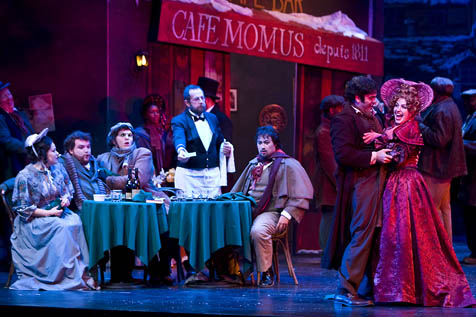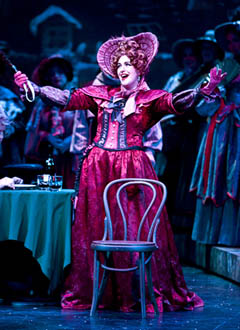La Bohme
At the Lobero Theatre, Friday, August 3.

At the height of Fiesta and in the heart of downtown, a large audience gathered at the Lobero to participate in a different kind of spectacle-the opera La Bohme, as performed by the Music Academy of the West. The contrast between the interior of the theater and the revelry outside in the streets was not as great as one might think. Opera audiences are among the most festive and demonstrative in all of music, and this one was no exception. They clapped, they cheered, they stomped their feet and shouted “Brava!” after particularly exciting moments, all in response to an unusually fine production of one of opera’s all-time greatest hits.
La Bohme is just four short acts. In the first, the love between the poet Rodolfo and the seamstress Mim kindles from a spark into a conflagration in a matter of minutes. The sudden intensity of their feeling cues Mimi’s famous aria, “S, mi chiamano Mim.” Tenor Noah Baetge was a rich and satisfying Rodolfo and had great rapport with soprano Leticia Brewer, who made the most out of Mim-an unusually exposed role that requires great daring and skill.

The second act revealed the dynamics of the parallel love affair between the second soprano, Musetta (Amber Opheim), and the baritone, Marcello (Alexander Tall). The scene in which Musetta at long last wins the attention of Marcello, who has been giving her the cold shoulder, is one of the most glorious pieces of stage action in any theatrical drama, in or out of the opera. The singers were both excellent, with Musetta looking glamorous in an unearthly headdress and Marcello almost stealing the scene with the uproarious abruptness of his entry to their waltz duet.
So many things must come together for a fully staged version of this opera, and director Casey Stangl and conductor Christopher Larkin are to be congratulated for pulling off a thorough and satisfying production, right down to the children’s chorus and the band of piccolos, trumpets, and snare drum.
Acts three and four were devoted to the romantic suffering of the lovers and the tragic death of the heroine. Brewer and Baetge once again claimed our complete attention; first for the question of whether or not Mim and Rodolfo should continue their affair (the answer is yes, but just for the winter), then for the famous death scene, which was genuinely cathartic and left many onstage and elsewhere with wet faces.



